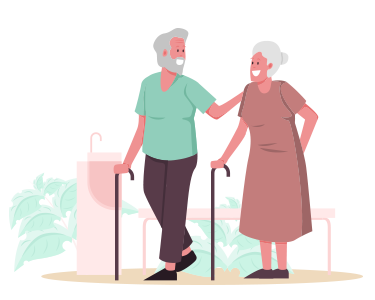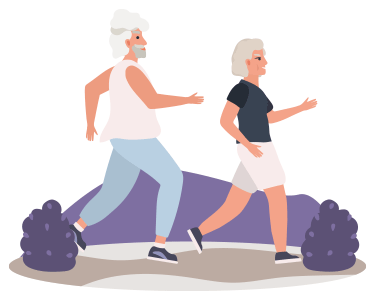 FeelFree is dedicated working on incontinent solution. To provide a better quality of products with more humanity optimizations.
FeelFree is dedicated working on incontinent solution. To provide a better quality of products with more humanity optimizations.
Here are some tips and advices for home carer.
About Incontinence
Urinary incontinence refers to the leakage of urine from the urethra under involuntary circumstances. According to the severity of urinary incontinence, it can be divided into four types::
- Urinary/abdominal pressure incontinence: urine will flow out when coughing, sneezing, or lifting heavy objects.
- Urgent urinary incontinence: When the patient feels the urge to urinate, he/she can't hold it before reach toilet.
- Overflow urinary incontinence: The bladder does not able to release all urine out, always left a little extra and leak out.
4.Complete urinary incontinence: even in a static state, there will be leakage of urine
There are about three causes of urinary incontinence:
- Caused by disorders of the urinary system, such as urinary tract infection, aging of urethral muscle function, leading to weakened sphincter resistance.
- Women are caused by childbirth or diseases, such as prolific birth, damage to the birth canal and vagina after childbirth, hysterectomy, urethral muscle instability due to aging, etc.
- Caused by anatomical pathologies, such as spinal injuries, neuropathic diabetes, Prostate hypertrophy..etc.
Back to normal life
 If you have urinary incontinence, you can make some changes that will help you control it.
If you have urinary incontinence, you can make some changes that will help you control it.
Avoid Bladder Irritants
If you find some food or drinks make your symptoms worse, try to avoid them. Some people have problems with caffeine, citrus, or alcohol. These can make the urge to pass urine stronger. Avoiding them will help ease these problems.
Schedule Your Fluid Intake
Most of the fluids you drink will reach your bladder within 2 to 3 hours. It's best to time your intake to those hours when you know you'll be near a restroom. If you wake at night to pass urine, it may be helpful to stop drinking fluids 3 hours before you go to bed.
Try the suitable pad/container
There are many devices that will catch urine. Small amounts can be controlled with sanitary napkins or special condoms (for men). Larger amounts can be absorbed by pull up pants (Like underwear). These have high-tech linings that prevent moisture from breaking down your skin. The use of collectors and pads, along with scheduling your fluid intake, can turn some bigger incontinence problems into minor ones.
It is possible to have a normal life even the incontinence issue occurs. FeelFree offers a way to live with it.
- Make sure your bladder is empty, then sit or lie down.
- Tighten your pelvic floor muscles. Hold tight and count 3 to 5 seconds.
- Relax the muscles and count 3 to 5 seconds.
- Repeat 10 times, 3 times a day (morning, afternoon, and night).
It is defined by absorbency rate –
〈200 cc: Mild incontinence products
200-500: Moderate incontinence products
〉500 cc: Severe Incontinent products.
With the correct concept & products to use, everyone can live a normal and free life like ordinary people!
What are bedsores?
Bedsores can happen when a person is bedridden or otherwise immobile, unconscious, or unable to sense pain. Bedsores are ulcers that happen on areas of the skin that are under pressure from lying in bed, sitting in a wheelchair, or wearing a cast for a prolonged time. Bedsores are also called pressure injuries, pressure sores, pressure ulcers, or decubitus ulcers.A bedsore develops when blood supply to the skin is cut off for more than 2 to 3 hours. As the skin dies, the bedsore first starts as a red, painful area, which eventually turns purple. Left untreated, the skin can break open and the area can become infected.
A bedsore can become deep. It can extend into the muscle and bone. Once a bedsore develops, it is often very slow to heal. Depending on the severity of the bedsore, the person's physical condition, and the presence of other diseases (such as diabetes), bedsores can take days, months, or even years to heal. They may need surgery to help the healing process.
Bedsores often happen on the:
- Buttocks area (on the tailbone or hips)
- Heels of the feet
- Shoulder blades
- Back of the head
- Backs and sides of the knees
Bedsores are divided into 4 stages, from least severe to most severe. These are:
- Stage 1. The area looks red and feels warm to the touch. With darker skin, the area may have a blue or purple tint. The person may also complain that it burns, hurts, or itches.
- Stage 2. The area looks more damaged and may have an open sore, scrape, or blister. The person complains of significant pain and the skin around the wound may be discolored.
- Stage 3. The area has a crater-like appearance due to damage below the skin's surface.
- Stage 4. The area is severely damaged and a large wound is present. Muscles, tendons, bones, and joints can be involved. Infection is a significant risk at this stage.
A wound is not assigned a stage when there is full-thickness tissue loss and the base of the ulcer is covered by slough or Escher is found in the wound bed. Slough may be tan, grey, green, brown, or yellow in color. Eschar is usually tan, brown or black.
Tips for reducing the risk of pressure sores include:
- changing positions frequently, between every 15 minutes to every 2 hours, depending on a person’s needs
- inspecting the skin every day
- keeping the skin clean and dry
- maintaining good nutrition
- quitting smoking and avoiding secondhand smoke
- doing exercises, even while in bed, to encourage circulation
Anyone who may have a pressure sore should notify their caregiver or a healthcare professional as soon as possible.




